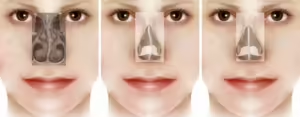Easy to Understand Summary:
The study “Nasal Septal Deviation in the Pediatric and Adult Populations” explains why and how the inside of your nose might get crooked as you grow older, perhaps leading to a desire or need for a rhinoplasty. Here’s what you need to know:
WHY DO NOSES GET CROOKED?
It’s Part of Growing Up: The research shows that the wall inside your nose, known as the septum, tends to bend more as you get older. It’s not usually something you’re born with; it develops more often as you age.
Changes Over Time: As kids turn into adults, their nasal septum keeps growing. If it doesn’t grow evenly, it can start to lean one way or the other, leading to what’s called a deviated septum.

HOW DOES SEPTAL DEVIATION HAPPEN?
Growing Pains: Your septum grows as you do. If it grows weirdly—faster on one side than the other, for instance—it can start to deviate.
Natural Changes: Just like the rest of your body changes as you grow, so does your septum. Sometimes these changes can make it bend as part of the normal aging process.
Microtraumas: If you keep bumping your nose or putting pressure on it, over time, it can make the wall inside your nose (the septum) shift out of place, causing septal deviation.
HOW DR. SHAH FIGURED THIS OUT:
Measurements: The researchers, including Dr. Shah, used something called the “tortuosity index,” which basically checks how twisty your septum is compared to a perfectly straight line.
High-Tech Scans: The researchers looked at CT and MRI scans of people’s noses from babies to grown-ups. This let them see in detail how septums change with age.
In essence, this study tells us that getting a crooked septum is more about how you grow rather than something you’re stuck with from birth. It’s part of growing up, and knowing this can help doctors better understand and treat people who might need help with their deviated septums.
Advanced Reading:
Scholarly Level Content
Please note that the content of this article is written at a scholarly, medical level and may be difficult to understand if you are not familiar with medical terminology or advanced concepts in this area. We recommend using our glossary of key terms to aid in your understanding of this section of the article.
The article “Nasal Septal Deviation in the Pediatric and Adult Populations” by Reitzen SD, Chung W, Shah AR explores the prevalence and potential causes of nasal septal deviation across different age groups. Utilizing computed tomography (CT) and magnetic resonance imaging (MRI) scans of 81 patients who underwent head and neck imaging for various reasons, the study divides subjects into four age categories: younger than 4 months; 4 months to less than 5 years; 5 to 15 years; and more than 15 years.
The study introduces a novel measure called “tortuosity” to examine and compare the degree of nasal septal deviation among these groups. Tortuosity is defined as the ratio of the actual length of the septum to its ideal (straight) length. The findings indicate that subjects under 5 years of age exhibit significantly less septal tortuosity compared to older children and adults, suggesting a higher frequency of nasal septal deviation in the latter groups.
These observations lead the authors to conclude that nasal septal deviation occurs more frequently in older children and adults, implying a noncongenital etiology for most cases. However, the continued growth of the septum throughout childhood and the potential for a genetic predisposition to later development of a deviated nasal septum are not ruled out by these findings.
This study is significant as it uses a uniform measure to compare septal deviation across different age groups for the first time, providing insights that may suggest the majority of nasal septal deviations develop postnatally rather than being present at birth (Reitzen, Chung, & Shah, 2011).
The video in this post has been transcribed using an automated service. Please forgive any typographic errors or other transcription flaws.
Dr. Shah:
I’m gonna be talking about a scientific article I published and why it’s relevant to almost anyone listening. First of all, this article we’re talking about deviated septum. For those who don’t know, the septum is that bone that divides your nose into two different halves. And according to most studies, 80% of the population to 85% of the population has a deviated septum according to like real life knowledge. And me looking at osis, I actually think it’s closer to 95% or higher. And the question is, why are there so many deviated septums? What’s causing this? So that is the genesis of the study. The initial thought was we would look at neonates, and neonates are basically babies under the age of one. Compare those to toddlers and compare those to adults. And in this study we kind of wanted to find out where are the deviated septums, when are they occurring?
And then can we kind of come up with any co conclusions of why they’re occurring? And so in neonates, we didn’t really find deviated septums happening. So what that means is either birth trauma or genetics, we’re not really seeing that. Cause like you’re not born with a deviated septum because your parents had a deviated septum. When you go into the toddler age and you go into the adult age, that’s when you start to see deviated septum and that’s when they start to appear to occur. So the question is why do they occur? So why do they occur? I think it’s two factors. One factor is gonna be microtraumas and traumas. You have, and this just comes from experience of having uh, three kids. Lots of times they’ll have little accidents that happen with their kids and they fall down and things of that nature. And no one really reports that.
But I think those microtraumas might influence the nose a little bit on how it’s growing and can cause some deviation. The second thing that could potentially cause that is the nose itself. As it’s growing, the septum grows, it runs out of space and it tends to tilt a go to the side. And that’s that part of the septum that’s deviated that most people don’t recognize. So take home message. If you do have a deviated septum, which you probably do if you’re listening to this, don’t blame mom and dad. Maybe blame a sibling who may have pushed you down when you’re little or that bully. And then know that there’s different ways of correcting it if you need to.

